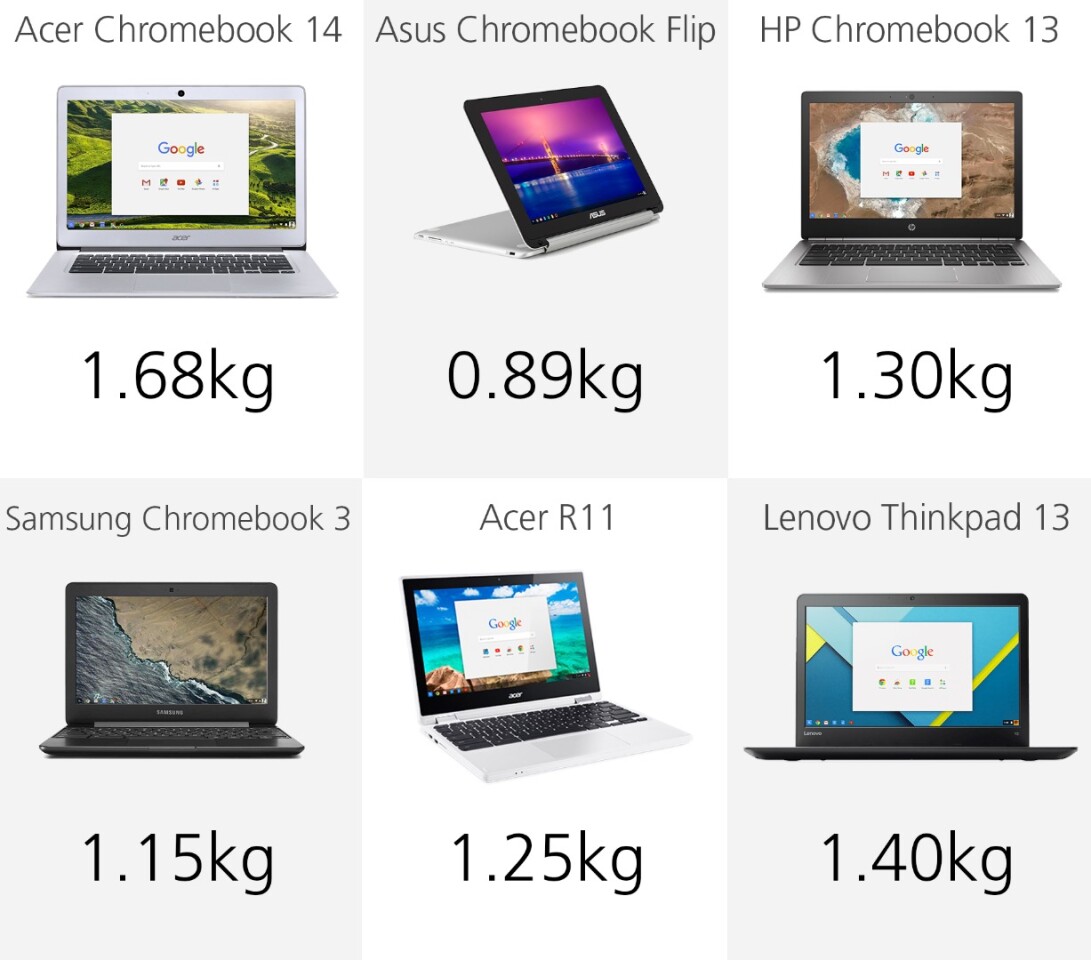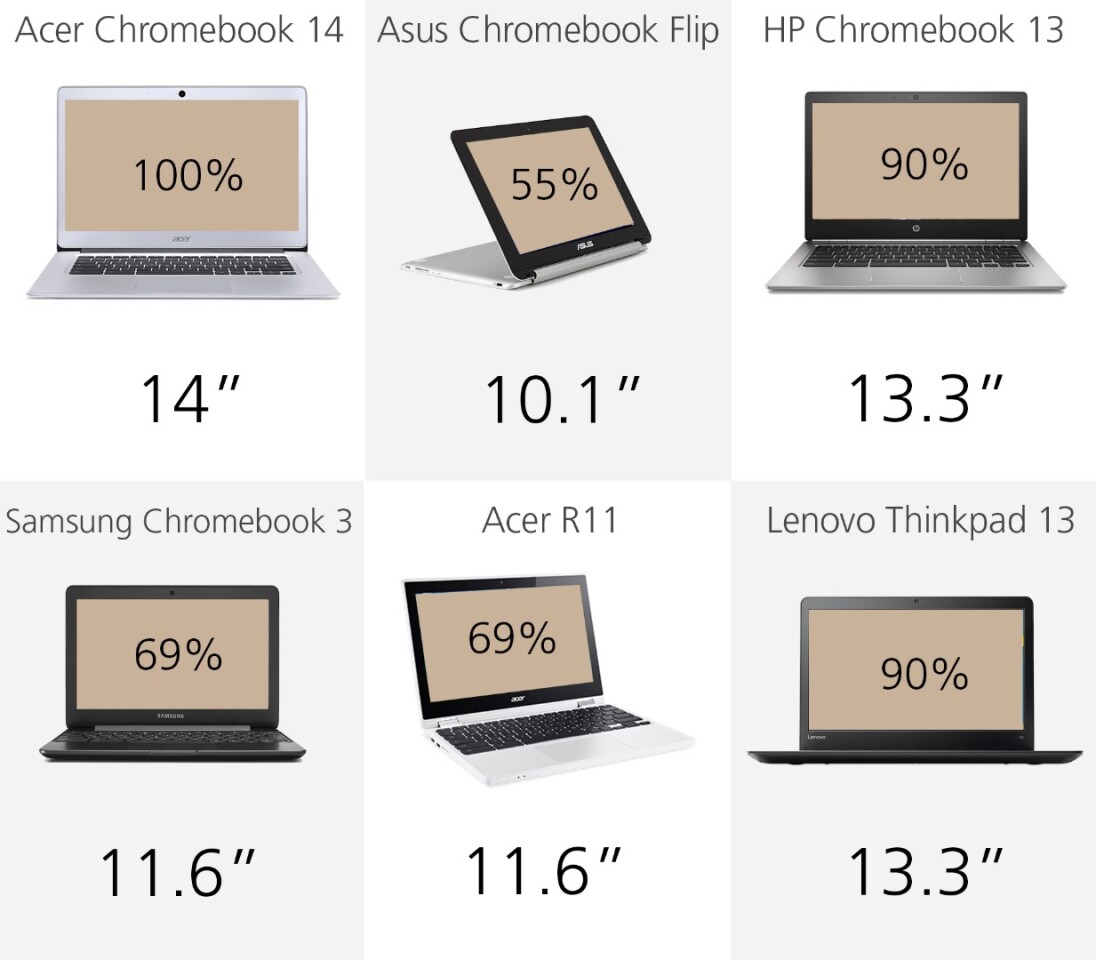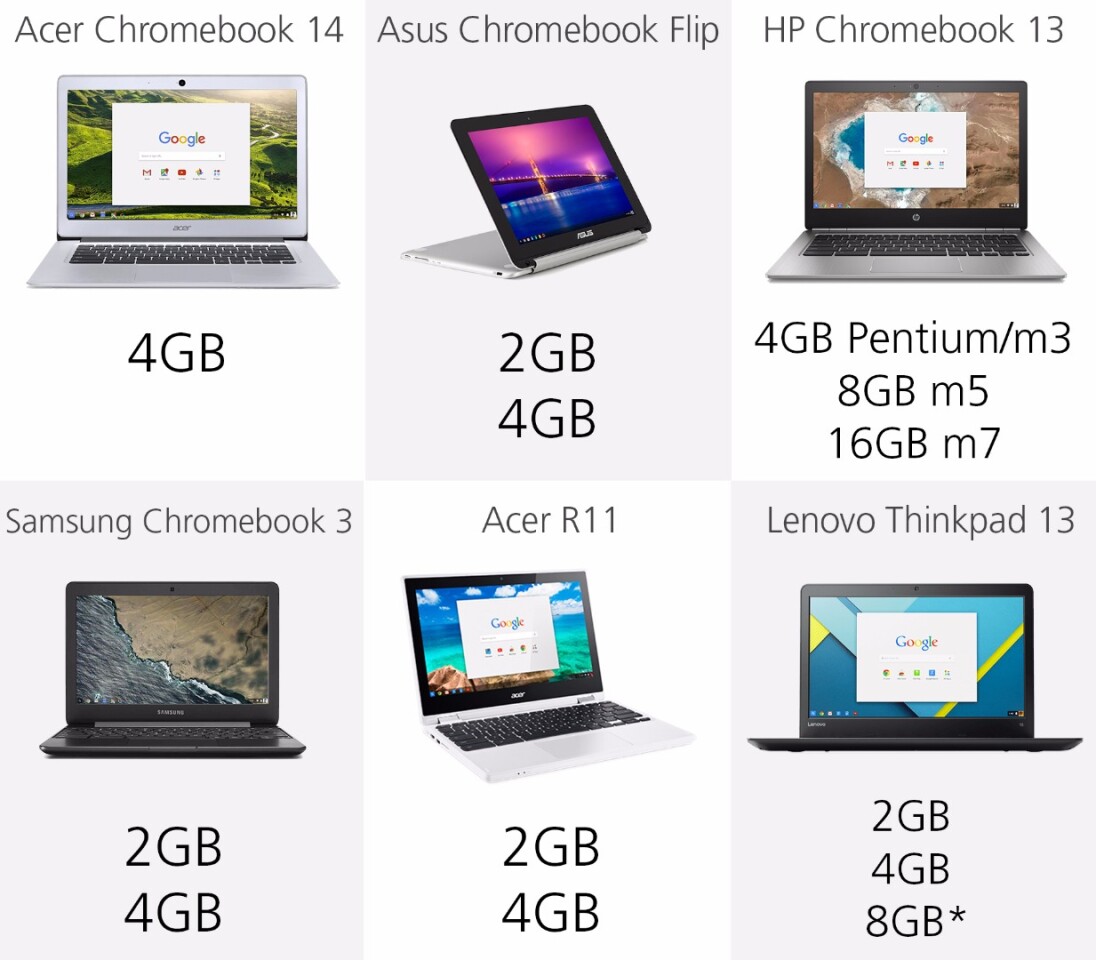Chromebooks – low-priced, Wi-Fi-dependent, long-lasting laptops that run on Chrome OS – make more sense than ever. They lend themselves to both student and professional use and offer easy access to cloud-based media and documents. If you're on the market for one, here's a close comparison of our top picks.
In this guide
In this guide, we're examining the following six machines side-by-side: Acer Chromebook 14 (both the entry level and "Work" models), Asus Chromebook Flip, HP Chromebook 13, Samsung Chromebook 3, Acer Chromebook R11 and the Lenovo Thinkpad 13 Chromebook (not to be confused with the Windows-running variant of the same make and model).
What is a Chromebook?
Before we get started, let's clarify exactly what to expect from this type of device. By definition, Chromebooks run Chrome OS. This is an open-source desktop software developed by Google; updates are free and automatic on most machines.
On Chrome OS, you can surf the web using the Chrome browser and put the suite of Google apps to work: Mail, Docs, Sheets, Hangouts, etc. There are also many additional Chrome OS apps that can be purchased through the Chrome web store. What can't a Chromebook do? Run desktop apps.
If you need a computer just to get online, a Chromebook is a solid choice, and any of the options below may work for you. But if you need to conduct extensive image or video editing, play non-Chrome-based games, or there are other offline apps you constantly use, then you should definitely upgrade to a different kind of laptop.
Size

The Asus Chromebook Flip is the smallest in our lineup, and the Acer Chromebook 14 is the largest. The Samsung Chromebook 3 and Acer R11 are similarly sized on the smaller end of the spectrum, while the HP and Lenovo options fall on the larger end.
Weight

If you can't stand the thought of lugging around more weight in your bag, backpack or briefcase, opt for a lighter machine. The little Asus Chromebook Flip is also the lightest; it's about half the weight of the relatively hulking Acer Chromebook 14. Everything else in this crop of Chromebooks falls within the 1.15–1.4 kg range.
Build

The Acer Chromebook R11 has a mostly plastic body, with a metal panel on the lid of the machine. The Lenovo Thinkpad is entirely plastic.
The higher-end builds are metal. The Acer Chromebook 14 and the HP option have the most premium builds of this selection, bringing to mind a MacBook Air with their sleek metal unibodies.
Convertible

The Asus Chromebook Flip and Acer R11 are convertible laptop/tablets, also known as 2-in-1s. Their 360-degree hinges let you hold or prop them in a variety of positions. If you don't want to hold it like a normal laptop, you can fold the keyboard underneath to use it like a tablet, or stand it up like a table tent.
Touchscreen

The convertible options have touchscreens to provide the aforementioned 2-in-1 versatility. In addition, Lenovo has said that a touchscreen version of the Thinkpad 13 Chromebook is coming soon.
Colors

No exciting colors in this lineup – we're looking at metallics and neutrals. Only the Acer Chromebook 14 has more than one color option.
Keyboard perks

These machines all have basic plastic chiclet keyboards. The exceptions? The HP Chromebook 13 also adds backlighting, for better typing in the dark, and the Samsung keyboard adds water resistance.
Display size

Relative display sizes align with the overall size specs. The Acer Chromebook 14 display is the largest, followed by the HP and Lenovo offerings, then the Samsung and Acer R11. The petite Asus Flip display is a full 45-percent smaller than the largest Acer.
Display resolution

Chromebooks don't tend to have super impressive displays, because that would be a bit of a waste: You don't usually need an astrological pixel count for filling in a spreadsheet or sending e-mails. Still, if you're a stickler when it comes to screens, then the 3,200 x 1,800 HP Chromebook 13 is the obvious choice.
Battery

Chromebooks are known for their long battery life, since they're designed to be used on-the-go for an entire school or work day.
Manufacturers' battery life estimates are included here. These should be taken loosely, since there are many factors that go into battery life, but the HP offering will likely be the first to have you scrambling for a charger (probably due to that pixel-dense display).
Camera

All of these machines have 720p webcams for video conferencing, Google Hangouts and the like. Don't expect a high-end selfie experience, but these will get the job done.
RAM

Memory levels range from 2 GB to 16 GB. The 8 GB version of the Thinkpad is only available on its highest-end processor configuration (see "Processor" below).
Storage

You may already have a thumb drive or two with more storage capacity than your average Chromebook. On the plus side, they tend to have more USB ports than many of this year's high-end laptops, and they tap right into your Google Cloud storage.
Again, the higher-capacity version of the Thinkpad is only available with the premium processor.
Expansion slot

Only the Acer Chromebook 14 is missing an expansion card slot. The others make space for either a microSD or SD card.
USB ports

Every one of these machines has at least two USB ports, for peripherals and external storage alike. The HP Chromebook and Lenovo Thinkpad are the only two that include the newest USB standard, USB Type C.
Audio

Don't expect a compelling audio experience from these intentionally thrifty devices, but each of these Chromebooks has a pair of stereo speakers. Only the HP Chromebook has third-party branded speakers (Bang & Olufsen).
They also all have headphone jacks, so you can stream music or watch videos without bothering your neighbors.
Processor

Chromebooks don't need the same kind of computing power that regular laptops do, since they are incapable of running heavy-duty desktop apps. Still, a better processor often means faster, smoother performance, and the HP Chromebook and Lenovo Thinkpad offer some configurations that dominate the other chipsets.
Graphics

All of these have comparable integrated graphics.
Video out

On the machines that have HDMI or microHDMI ports, you'll be able to run a cable directly from your Chromebook to an external display. For the USB-C sporting machines, you'll need an adapter.
Android app support

Chromebooks are on the cusp of supporting Android apps from the Google Play store, which dramatically increases their content library and by extension, the number of ways that Chromebooks can be used.
The Acer R11 and Asus Chromebook Flip already support Android apps, while the other selections are expected to receive Android compatibility sometime in 2017.
Release

This lineup includes four 2016 models and two 2015 models. Though the 2-in-1 options were released last year, they have remained popular enough to stay on our radar.
Starting price

Yes, you've read correctly – Chromebooks, even ones with premium specs and builds, are usually a fraction of the price of standard laptops. It's possible to score a very capable internet-surfing Chromebook without making much of an investment.
It's likely that you will be able to find prices even lower than those listed here. For example, the Samsung Chromebook 3 is listed with an MSRP of $200, but it's currently available through Samsung or Amazon for US$170. The Lenovo Thinkpad Chromebook is configured on the Lenovo website for $386, but entry-level models are available on Amazon starting at $265.
For more year-end buyer's guides, you can hit up our comparisons of the latest MacBooks, laptops and 2-in-1s.


























